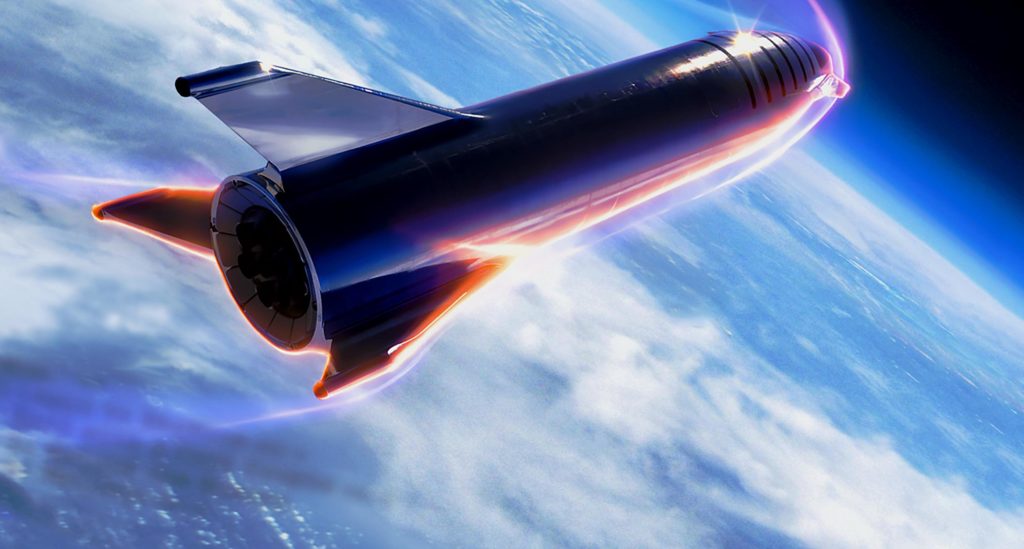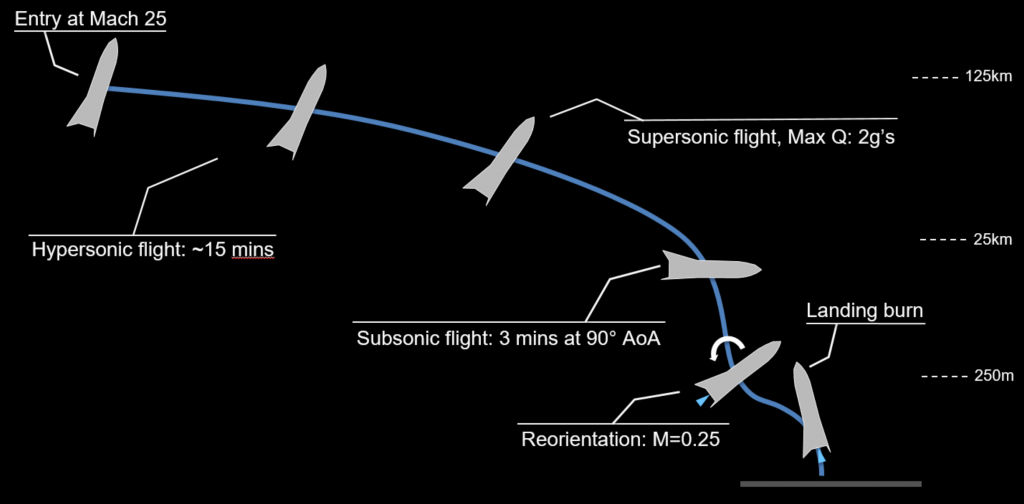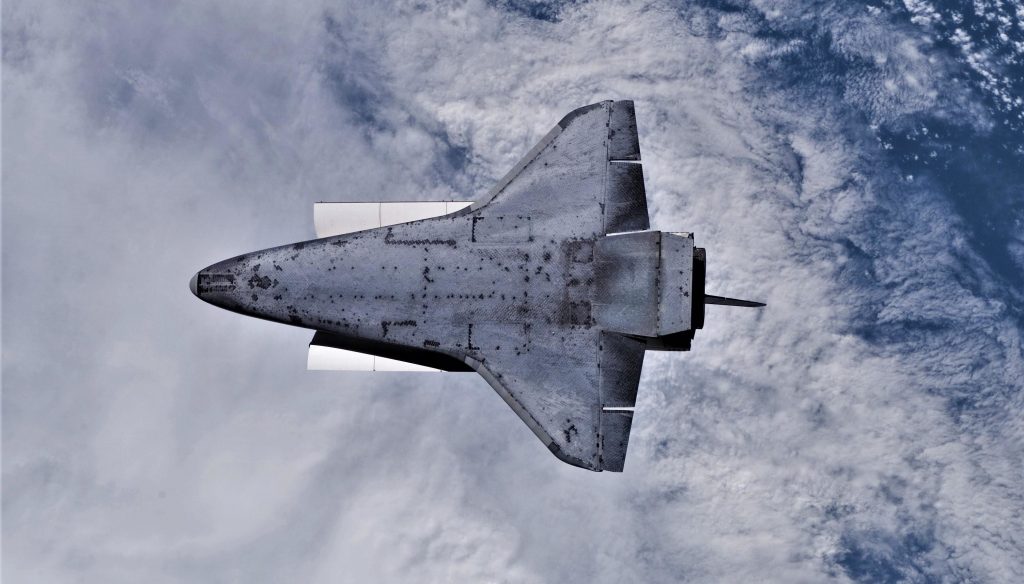

News
SpaceX CEO Elon Musk explains how Starships will return from orbit
In the near future, SpaceX wants to begin putting its first two full-scale Starship prototypes through a series of increasingly challenging test flights, eventually culminating in their first Super Heavy-supported orbital launch attempts.
SpaceX CEO Elon Musk took to Twitter over the last 48 or so hours to answer a number of questions about how exactly Starship is meant to make it through orbital reentries – by far the most strenuous period for the ship and without a doubt the single most challenging engineering problem SpaceX must tackle.

Discussed yesterday on Teslarati, SpaceX technicians began the process of attaching numerous Tesla Model S/X battery packs to a subcomponent that will eventually be installed inside Starship Mk1’s nose, offering a storage capacity of up to 400 kWh. The need for all that power (Crew Dragon relies on a few-kWh battery) is directly related to Starship Mk1’s methods of reentry and recovery, recently described in detail by Elon Musk.
As noted above, ~400 kWh of batteries are needed to power the electric motors that will actuate Starship’s massive control surfaces – two large aft wings and two forward canards/fins. According to Musk, Starship’s “stability is controlled by (very) rapid movement of rear & fwd fins during entry & landing”, meaning that the spacecraft will need to constantly tweak its control surfaces to remain in stable flight.

By far the biggest challenge SpaceX faces is ensuring that Starship can survive numerous orbital-velocity reentries with little to no wear and tear, a necessity for Starship to be cost-effective. In Low Earth Orbit (LEO), Starship will be traveling no less than 7.8 km/s (Mach 23, 17,500 mph) at the start of atmospheric reentry. In simple terms, the process of slowing from orbital velocity to landing on Earth involves turning the vast majority of that kinetic energy into heat. As Musk noted yesterday, this reality is just shy of unavoidable but there is some flexibility in terms of how quickly one wants to convert that energy into heat.
The fastest route to Earth would involve diving straight into the atmosphere, dramatically increasing peak heating on a spacecraft’s surface to the point that extremely exotic heat shields and thermal protections systems become an absolute necessity. SpaceX wants to find a middle ground with Starship in which the spacecraft uses its aerodynamic control surfaces and body to generate lift, slowly and carefully lowering itself into Earth’s atmosphere over a period of 15+ minutes. Musk notes that this dramatically lessens peak heating at the cost of increasing the overall amount of energy Starship has to dissipate, a bit like cooking something in the oven at 300 degrees for 30 minutes instead of 600 degrees for 10 minutes.
To an extent, Starship’s reentry profile is actually quite similar to NASA’s now-retired Space Shuttle, which took approximately 30 minutes to go from its reentry burn to touchdown. Per the above infographic, it looks like Starship will take approximately 20 minutes from orbit to touchdown, owing to a dramatically different approach once it reaches slower speeds. Originally described by Musk in September 2018 and again in recent weeks, Starship will essentially stall itself until its forward velocity is nearly zero, after which the giant spacecraft will fall belly-down towards the Earth, using its wings and fins to maneuver like a skydiver. The Space Shuttle landed on a runway like a (cement-encased) glider.
This unusual approach allows SpaceX to sidestep the need for huge wings, preventing Starship from wasting far more mass on aerodynamic surfaces it will rarely need. The Space Shuttle is famous for its massive, tile-covered delta wing and the leading-edge shielding that partially contributed to the Columbia disaster. However, it’s a little-known fact that the wing’s size and shape were almost entirely attributable to US Air Force demands for cross-range performance, meaning that the military wanted Shuttles to be able to travel 1000+ miles during reentry and flight. This dramatically constrained the Shuttle’s design and was never once used for its intended purpose.

SpaceX thankfully doesn’t have its own “US Air Force” stand-in making highly consequential demands (aside from Elon Musk ?). Instead, Starship will continue the SpaceX tradition of vertical landing, falling straight down – a bit like a skydiver (or a brick) – on its belly and flipping itself over with fins and thrusters for a propulsive vertical landing. In this way, Starship doesn’t have to be a brick forced to fly, like the Shuttle was – it just needs to be able to stably fall and quickly flip itself from a horizontal to vertical orientation.
Additionally, Starship is built almost entirely out of steel, whereas the Shuttle relied on an aluminum alloy and needed thermal protection over every square inch of its hull. Steel melts at nearly twice the temperature of the Shuttle’s alloy, meaning that Starship will (hopefully) be able to get away with nothing more than ceramic tiles on its windward half, saving mass, money, and time. Once Starship completes its first 20 km (12.5 mi) flight test(s), currently scheduled no earlier than mid-October, SpaceX will likely turn its focus on verifying Starship’s performance at hypersonic speeds, ultimately culminating in its first orbital-velocity reentries.
Check out Teslarati’s Marketplace! We offer Tesla accessories, including for the Tesla Cybertruck and Tesla Model 3.
News
SpaceX’s Crew-11 mission targets July 31 launch amid tight ISS schedule
The flight will lift off from Launch Complex 39A at Kennedy Space Center in Florida.

NASA and SpaceX are targeting July 31 for the launch of Crew-11, the next crewed mission to the International Space Station (ISS). The flight will lift off from Launch Complex 39A at Kennedy Space Center in Florida, using the Crew Dragon Endeavour and a Falcon 9 booster.
Crew Dragon Endeavour returns
Crew-11 will be the sixth flight for Endeavour, making it SpaceX’s most experienced crew vehicle to date. According to SpaceX’s director of Dragon mission management, Sarah Walker, Endeavour has already carried 18 astronauts representing eight countries since its first mission with NASA’s Bob Behnken and Doug Hurley in 2020, as noted in an MSN report.
“This Dragon spacecraft has successfully flown 18 crew members representing eight countries to space already, starting with (NASA astronauts) Bob (Behnken) and Doug (Hurley) in 2020, when it returned human spaceflight capabilities to the United States for the first time since the shuttle retired in July of 2011,” Walker said.
For this mission, Endeavour will debut SpaceX’s upgraded drogue 3.1 parachutes, designed to further enhance reentry safety. The parachutes are part of SpaceX’s ongoing improvements to its human-rated spacecraft, and Crew-11 will serve as their first operational test.
The Falcon 9 booster supporting this launch is core B1094, which has launched in two previous Starlink missions, as well as the private Ax-4 mission on June 25, as noted in a Space.com report.
The four-members of Crew-11 are NASA astronauts Zena Cardman and Mike Fincke, as well as Japan’s Kimiya Yui and Russia’s Oleg Platonov.
Tight launch timing
Crew-11 is slated to arrive at the ISS just as NASA coordinates a sequence of missions, including the departure of Crew-10 and the arrival of SpaceX’s CRS-33 mission. NASA’s Bill Spetch emphasized the need for careful planning amid limited launch resources, noting the importance of maintaining station altitude and resupply cadence.
“Providing multiple methods for us to maintain the station altitude is critically important as we continue to operate and get the most use out of our limited launch resources that we do have. We’re really looking forward to demonstrating that capability with (CRS-33) showing up after we get through the Crew-11 and Crew-10 handover,” Spetch stated.
Lifestyle
EV fans urge Tesla to acquire Unplugged Performance for edge in fleet and security industry
Unplugged Performance has built a name for itself by producing performance upgrades for Tesla vehicles.

A growing number of Tesla enthusiasts and longtime community voices are calling on the electric vehicle maker to acquire Unplugged Performance, a California-based aftermarket company best known for tuning Tesla vehicles and developing specialized government fleet solutions under its UP.FIT division.
The idea was once considered a niche proposal among EV fans, but it is now gaining serious attention not just as a performance play but as a strategic move to deepen Tesla’s roots in the fleet and security industry.
A strategic fit
Unplugged Performance has built a name for itself by producing performance upgrades for Tesla vehicles, from track-optimized components to visual and aerodynamic upgrades. But in recent years, its UP.FIT division has pivoted toward a more functional future by outfitting Tesla vehicles like Model Ys for police, military, and government use.
That work has sparked growing calls for closer collaboration with Tesla, especially as the EV maker increasingly leans into autonomy, AI, and fleet services as core components of its next chapter.
“I posted this four years ago, but I think it’s more true now than ever,” wrote Whole Mars Catalog, a well-known Tesla investor and FSD Beta tester, on X. “Tesla should buy Unplugged. But not just as a Performance division. What they are doing with UP.FIT unlocks large government and commercial fleet purchases that can improve utilization.”
Tesla fans such as shareholder Sawyer Merritt echoed the sentiment, calling Unplugged a “great fit within Tesla.” adding, “They are literally located directly next to Tesla’s design studio in Hawthorne.”
Enabling the next wave
Supporters of the idea noted that integrating Unplugged into Tesla’s corporate structure could help accelerate the adoption of autonomous technologies in government sectors. With UP.FIT patrol cars already in use across some U.S. police departments, Tesla fans envisioned a future where self-driving Teslas could potentially revolutionize law enforcement, search-and-rescue, and public service logistics.
“Just imagine how autonomous patrol cars could transform policing and bring us into a safer future,” the veteran FSD tester wrote.
The benefits could also extend to Tesla’s existing consumer base. “They also have some incredible products in the works that I think will appeal to many ordinary Tesla drivers — not just those looking for performance or mods. Stuff that’s so good it should have come straight from the design studio next door,” Whole Mars Catalog noted.
Unplugged Performance, founded in 2013, shares not just a product vision with Tesla, but also geography. Its Hawthorne headquarters sits directly adjacent to Tesla’s design studio, and the two companies have maintained a close working relationship over the years. The aftermarket firm has long positioned itself as a “mission-aligned” partner to Tesla.
In response to the recent calls for acquisition, Unplugged Performance acknowledged the support from the community. “Our very existence is to support the Tesla mission with @UpfitTesla and @UnpluggedTesla,” Unplugged CEO Ben Schaffer posted on X. “We love working with Tesla and are grateful for the community’s support since 2013!”
News
Tesla debuts hands-free Grok AI with update 2025.26: What you need to know
All new Tesla vehicles delivered on or after July 12, 2025, will include Grok AI out of the box

Tesla has begun rolling out Grok, an in-car conversational AI assistant developed by xAI, to eligible vehicles starting July 12. The feature marks the most direct integration yet between Elon Musk’s artificial intelligence startup and Tesla’s consumer product lineup, offering drivers hands-free access to a chat-style companion while on the road.
Grok comes pre-installed on new vehicles
According to Tesla’s FAQ page for the feature, all new vehicles delivered on or after July 12, 2025, will include Grok AI out of the box. Owners of older vehicles may gain access through an over-the-air update, provided their vehicle meets a few hardware and software requirements.
Specifically, Grok is currently only supported on Tesla models equipped with an AMD infotainment processor and running vehicle software version 2025.26 and higher. Compatible models include the Model S, Model 3, Model X, Model Y, and Cybertruck. A Premium Connectivity subscription or active Wi-Fi connection is also required.
Tesla notes that additional vehicle compatibility may arrive in future software updates.
Grok’s features and limitations for now
Drivers can engage with Grok using the App Launcher or by pressing and holding the voice command button on the steering wheel. Grok is designed to answer questions and hold conversations using natural language, offering responses tailored to its chosen personality—ranging from “Storyteller” to the more eccentric “Unhinged.”
For fun, Tesla posted a demonstration of Grok likely running on “Unhinged” talking about what it would do to Optimus when they are on a date, much to the shock of the humanoid robot’s official social media account.
It should be noted, however, that Grok cannot currently issue commands to the vehicle itself, at least for now. Traditional voice commands for tasks like climate control, navigation, or media remain separate from Grok as of writing.
The feature is being released in Beta and does not require a Grok account or xAI subscription to activate, although that policy may change over time.
Grok privacy and in-car experience
Tesla emphasizes that interactions with Grok are securely processed by xAI and not linked to a user’s Tesla account or vehicle. Conversations remain anonymous unless a user signs into Grok separately to sync their history across devices.
Tesla has also begun promoting Grok directly on its official vehicle webpages, showcasing the feature as part of its in-car experience, further highlighting the company’s increasing focus on AI and infotainment features on its all-electric vehicles.
-

 Elon Musk2 weeks ago
Elon Musk2 weeks agoTesla investors will be shocked by Jim Cramer’s latest assessment
-

 Elon Musk3 days ago
Elon Musk3 days agoxAI launches Grok 4 with new $300/month SuperGrok Heavy subscription
-

 Elon Musk5 days ago
Elon Musk5 days agoElon Musk confirms Grok 4 launch on July 9 with livestream event
-

 News1 week ago
News1 week agoTesla Model 3 ranks as the safest new car in Europe for 2025, per Euro NCAP tests
-

 Elon Musk1 week ago
Elon Musk1 week agoxAI’s Memphis data center receives air permit despite community criticism
-

 News2 weeks ago
News2 weeks agoXiaomi CEO congratulates Tesla on first FSD delivery: “We have to continue learning!”
-

 News2 weeks ago
News2 weeks agoTesla sees explosive sales growth in UK, Spain, and Netherlands in June
-

 Elon Musk2 weeks ago
Elon Musk2 weeks agoTesla scrambles after Musk sidekick exit, CEO takes over sales














